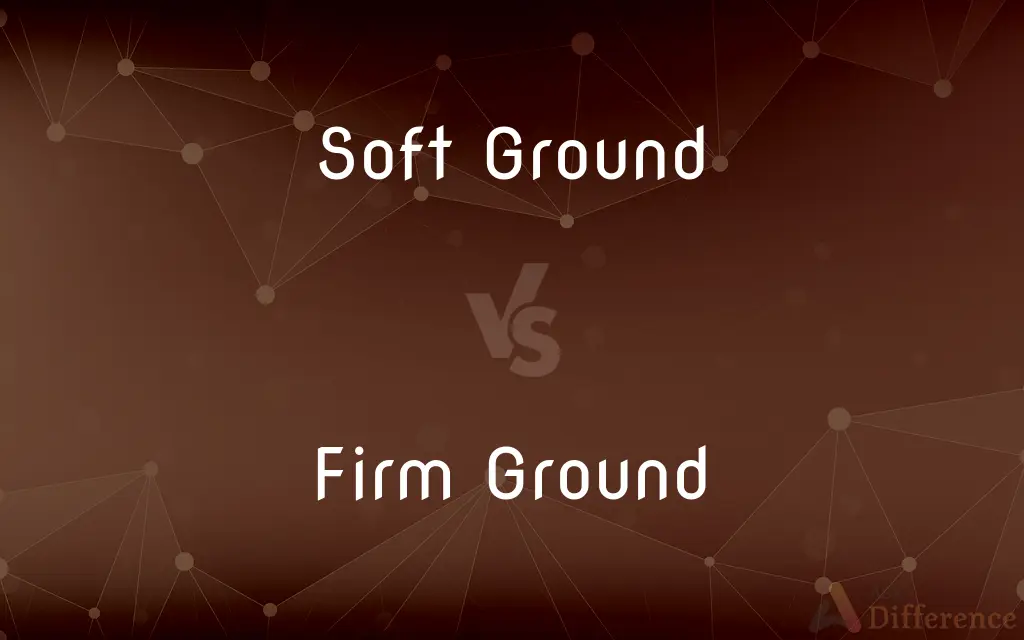Soft Ground vs. Firm Ground — What's the Difference?
By Tayyaba Rehman — Published on January 1, 2024
Soft Ground refers to terrain that is wet, muddy, or less compact, while Firm Ground indicates terrain that is dry, hard, or more compact.

Difference Between Soft Ground and Firm Ground
Table of Contents
ADVERTISEMENT
Key Differences
Soft Ground: Composed of wet, muddy, or loose soil, offering less stability and more slipperiness. Firm Ground: Consists of dry, hard, or well-compacted soil, providing better stability and less likelihood of sinking.
Soft Ground: More challenging for activities like walking or driving due to the potential for getting stuck or slipping. Firm Ground: Preferred for most outdoor activities, construction, and sports, as it provides a solid and stable surface.
Soft Ground: Requires specialized footwear with deeper treads for better grip. Vehicles may need off-road tires. Firm Ground: Regular footwear and equipment are usually sufficient, as the ground offers natural stability and grip.
Soft Ground: Can be problematic for heavy machinery in agriculture or construction due to the risk of sinking or getting bogged down. Firm Ground: More conducive to the use of heavy machinery and building structures, as it can support more weight without significant deformation.
Soft Ground: Often found in areas with higher rainfall or near water bodies. Can change seasonally. Firm Ground: Typical in arid or well-drained areas. Maintains its firmness throughout different seasons.
ADVERTISEMENT
Comparison Chart
Composition
Wet, muddy, loose soil
Dry, hard, compact soil
Suitability for Activities
Challenging for walking/driving
Suitable for most activities
Footwear/Equipment
Requires deep treads, off-road tires
Regular footwear/equipment suffices
Agricultural/Construction Use
Problematic for heavy machinery
Conducive to heavy machinery
Environmental Conditions
Higher rainfall, near water bodies
Arid, well-drained areas
Compare with Definitions
Soft Ground
Soil with high moisture content.
The farmer waited for the soft ground to dry before plowing the field.
Firm Ground
Ground that remains stable and unyielding under pressure.
The firm ground of the hiking trail made the long walk more comfortable.
Soft Ground
Ground that gives way under pressure.
The hikers found the soft ground near the riverbank challenging to cross.
Firm Ground
Well-compacted soil that supports weight and movement.
They set up the outdoor event on firm ground to ensure stability for the structures.
Soft Ground
Wet, loose, and slippery terrain.
Football players struggled to maintain their footing on the soft ground during the match.
Firm Ground
Terrain that is dry and hard.
The firm ground of the desert made it ideal for off-road biking.
Soft Ground
Less compact soil, easily deformed.
The soft ground in the garden was perfect for planting new seedlings.
Firm Ground
Hard-packed soil, offering good traction.
The soccer team preferred playing on firm ground for better control of the ball.
Soft Ground
Terrain that is wet and muddy.
After the heavy rains, the park was left with soft ground, making it difficult to walk.
Firm Ground
Dry, solid terrain, often found in arid areas.
The archaeological dig was conducted on firm ground to preserve the integrity of the site.
Common Curiosities
How does firm ground benefit agricultural practices?
Firm ground provides stable conditions for machinery use and can support the weight of heavy equipment without sinking.
What sports are most affected by soft ground conditions?
Sports like football, golf, and cross-country running can be significantly affected by soft ground, impacting movement and play.
Can the firmness of the ground change seasonally?
Yes, the firmness of the ground can change with seasons, especially in areas with variable rainfall patterns.
What type of footwear is recommended for soft ground?
Footwear with deep treads or spikes is recommended for soft ground to provide better grip and stability.
What conditions lead to soft ground?
Soft ground is often the result of high moisture content due to rainfall, proximity to water bodies, or soil composition.
How do hikers prepare for trails with soft ground?
Hikers prepare for soft ground trails by wearing appropriate footwear, checking trail conditions, and being ready for slower progress.
What are the main challenges of soft ground in construction?
In construction, soft ground can pose challenges like sinking of machinery, instability for structures, and difficulty in movement.
How is firm ground advantageous for outdoor events?
Firm ground is advantageous for outdoor events as it provides stability for structures and is comfortable for attendees to walk on.
Can landscaping be used to firm up soft ground?
Yes, landscaping techniques like grading, compacting, and adding drainage can help firm up soft ground.
What are the indicators of firm ground in nature?
Indicators of firm ground include dry, hard soil, lack of visible moisture, and vegetation typical of arid or well-drained areas.
How do environmentalists assess the impact on soft ground?
Environmentalists assess the impact on soft ground by studying soil composition, water retention, and the effects on local flora and fauna.
What types of buildings are suitable for soft ground?
Buildings with deep foundations or designed to distribute weight evenly are more suitable for soft ground.
How does weather affect the transition between soft and firm ground?
Weather, especially rainfall, plays a significant role in the transition between soft and firm ground, with wet conditions leading to softer soil and dry conditions resulting in firmer ground.
How do farmers manage crops on soft ground?
Farmers manage crops on soft ground by implementing drainage systems, using suitable machinery, and selecting crops that tolerate wet conditions.
What are common misconceptions about firm ground?
A common misconception is that firm ground is always completely safe and stable, disregarding the potential for hidden weaknesses.
Share Your Discovery

Previous Comparison
RJ11 vs. RJ45
Next Comparison
Java vs. Java EEAuthor Spotlight
Written by
Tayyaba RehmanTayyaba Rehman is a distinguished writer, currently serving as a primary contributor to askdifference.com. As a researcher in semantics and etymology, Tayyaba's passion for the complexity of languages and their distinctions has found a perfect home on the platform. Tayyaba delves into the intricacies of language, distinguishing between commonly confused words and phrases, thereby providing clarity for readers worldwide.














































